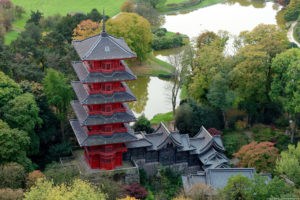The Brussels government has decided to protect the Chinese Pavilion and the Japanese Tower as heritage on Thursday.
Pascal Smet, the State Secretary for Urbanism, has been instructed by the Brussels government to urge the Federal government to start renovating both buildings, as it is officially responsible for their maintenance.
"Brussels has many architectural gems that bear witness to the rich history of our city. The Chinese Pavilion and the Japanese Tower are at the top of that list," Smet said, reports Bruzz.
"Today, the Brussels Region is sending a strong signal to the federal government to renovate these unique buildings as a matter of urgency. By protecting our heritage, we ensure that the people of Brussels can be proud of their city and give Brussels the international image it deserves," he said, adding that he is prepared to consider various ways to achieve that, including those with private support.
The Chinese Pavilion and the Japanese Tower were built between 1901 and 1905, by the order of King Leopold II. He wanted to build an open-air museum around his domain with buildings that referred to the Far East. Both buildings were designed by the Parisian architect Alexandre Marcel, who was inspired by 'Le Tour du Monde' at the 1900 World Exhibition in Paris.
In 1909, both buildings were donated to the Ministry of Foreign Affairs as a means of promoting Belgian relations with China and Japan, reports Het Laatste Nieuws.

The garden around the Japanese Tower is also protected. Credit: Regie der Gebouwen
The Chinese Pavilion is built in a typical South Chinese style with the recognisable roof shape. The ornaments on the facade and inside the building consist of a mix of different Chinese styles.
The woodwork of the Japanese Tower was ordered from a renowned Tokyo joinery, and then assembled in Laeken. The interior decoration incorporates original pieces from the Edo and Meiji periods (18th and 19th century Tokyo).
The garden around the Japanese Tower is also protected from now on, as it contains many remarkable trees, including the thickest Japanese Katsura tree in the region.
The Federal Government of the Buildings, which manages the buildings, reacts positively to the classification as heritage of both iconic buildings, said Smet.
Maïthé Chini
The Brussels Times

